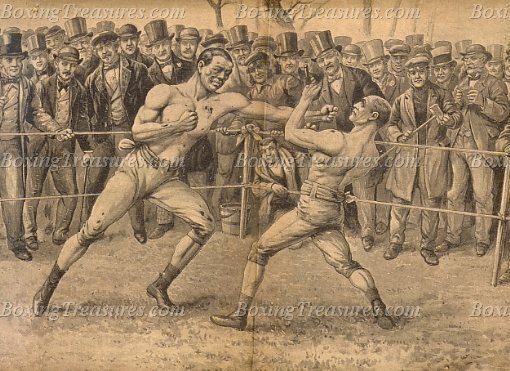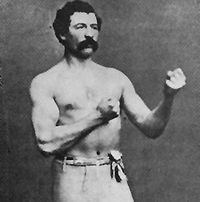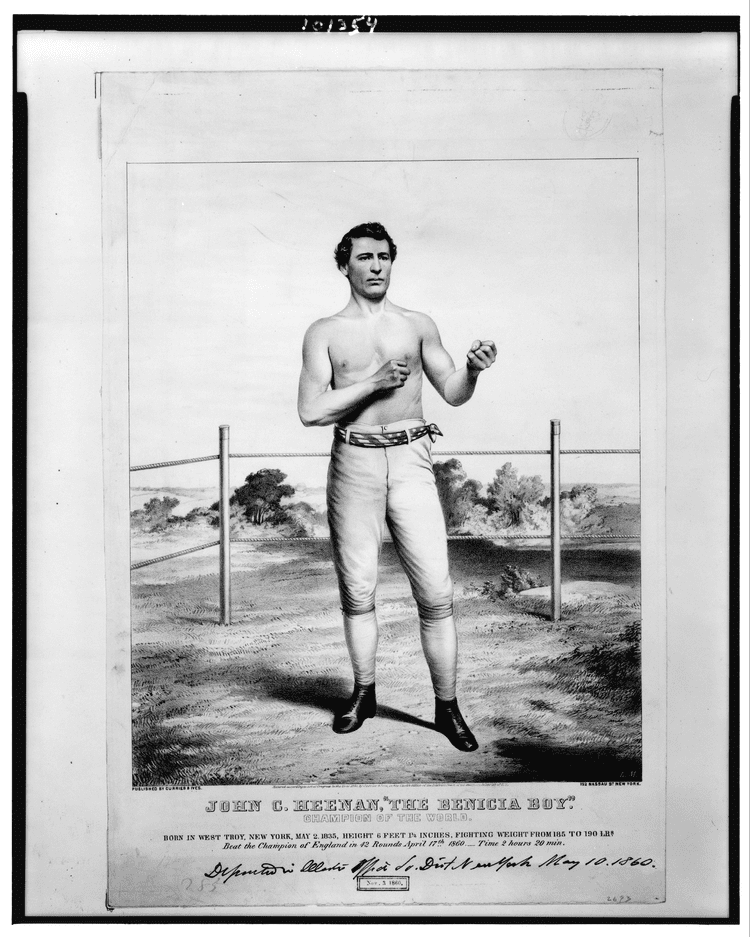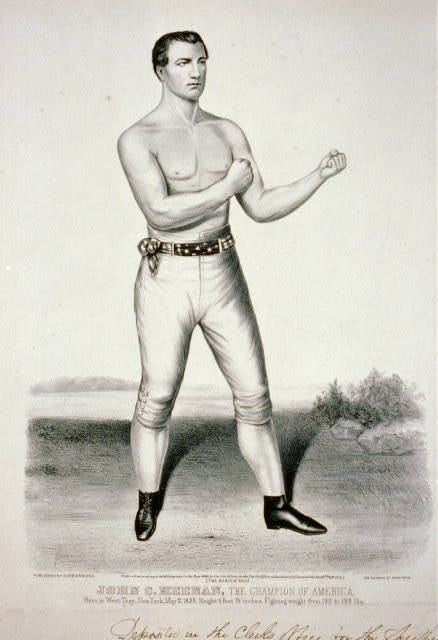Name John Heenan Height 1.88 m | Martial art Boxing | |
 | ||
Died October 28, 1873, Wyoming Territory | ||
John Camel Heenan, aka the Benicia Boy (2 May 1834–28 October 1873) was an American bare-knuckle prize fighter. Though highly regarded, he had only three formal fights in his entire career, losing two and drawing one.
Contents

Heenan is best remembered for his second contest, when he travelled to England to fight British champion Tom Sayers. The bout, generally seen as boxing’s first world championship, ended in chaos when spectators broke into the ring and the police intervened. The referee finally called a draw.

The Benicia Boy came home to a hero’s welcome, but later returned to England where he had just one more fight, losing controversially to new British champion, Tom King. He died at Green River Station, Wyoming Territory in October 1873, and is buried at St Agnes Cemetery, Albany, NY.

Early years

John Camel Heenan was born in May 1834 in West Troy (now Watervliet), NY, on the Hudson River. The family had come to upstate New York from Templemore, County Tipperary in Ireland shortly before, and after receiving an elementary education, the boy began work at Watervliet Arsenal, where his father was also employed.
Meanwhile, at Troy on the opposite bank of the river, lived John Morrissey. Three years older than Heenan, Morrissey had been born in America, but his family had also emigrated from Templemore. Their fathers had in fact been friends, but they fell out over a cock fight, and the two Johns inherited a bitter enmity.
At the age of seventeen, John Heenan crossed the continent to California, which had become a lawless and chaotic place following the 1849 gold rush. There is no detailed record of what he did there, but he is known to have spent some time in the workshop of the Pacific Mail Steamship Company in Benicia, which served as state capital in 1853–54. Six feet two inches tall, and weighing around 190 pounds, his strength and endurance became legendary, and his success in many casual brawls earned him the nickname Benicia Boy. Spotting his talent, itinerant English trainer Jim Cusick took him to New York, where it might best be exploited.
Prize ring career
The prize ring was in fact outlawed, but Heenan fought a legal exhibition bout against Joe Coburn, and made a living as a “shoulder hitter” – a strong-arm man who might be hired for enforcement or protection in the seamy and often violent worlds of New York business and politics. His efforts earned him a sinecure in the New York Customs House.
But Jim Cusick, determined that his easy-going protégé should not rest on his laurels, pushed him to challenge for the national title. The champion was his old foe John Morrissey, now one of New York’s most notorious thugs. After much wrangling, the two men finally met in 1858 – in Canada, where the US authorities could not intervene. Heenan, whose training had been disrupted by injury, and who was not fully fit, was an unlucky loser. According to Alan Wright's account in 'The Great Prize Fight', Heenan damaged his right hand on a ring post early on in the bout, making him fight one handed. Even so, he was getting the better of Morrissey which incurred the wrath of Morrissey's supporters who had bet heavily on their man. They were well known for employing violent and unpleasant methods to help their man and some accounts say they stepped on Heenan's damaged hand every time he went down. One journalist reported that they would punch Heenan in the kidneys when he leant against the ropes. The same account said that the referee did not try to contain this interference and suggested he may have been paid by Morrissey. Whatever the truth, Heenan failed to continue after the eighth round due to exhaustion.
He found solace in the arms of Adah Isaacs Menken, an actress of little talent but huge impact, with whom he contracted a short-lived marriage.
Morrissey, refusing a return bout, effectively retired from the ring. This was seen by many as indicating that Morrissey knew he could not get the better of Heenan in a fair fight. Heenan became champion by default, but had difficulty finding other opponents in America. Jim Cusick accordingly decided that his next fight should be against British champion Tom Sayers, to whom Heenan issued a challenge in 1859.
The big fight
The prize ring was also illegal in England, and by 1859 it was followed only by a small number of enthusiasts. But the Heenan–Sayers contest caught the public imagination in both countries. As Harper's Weekly put it, “the bulk of the people in England and America are heart and soul engrossed in a fight compared to which a Spanish bull-bait is but a mild and diverting pastime.” And on the other side of the Atlantic, The Manchester Guardian observed that “no pugilistic contest ever decided has excited so great an interest, both in this and other countries, as the forthcoming conflict between Sayers and Heenan.”
Heenan’s training (unlike that of Sayers) was frequently disrupted by the interventions of police and magistrates, but by the day of battle he was in prime condition, and confident of victory over an opponent eight years older, forty pounds lighter and five inches shorter. The fight came off at Farnborough in Hampshire on Tuesday, 17 April 1860.
In a fierce and protracted battle, both men were handicapped from an early stage – Sayers by an injury to his right arm, and Heenan by being unable to see through his swollen right eye. The action went on for forty-two rounds spread over more than two hours, by the end of which Heenan’s face was so cut and bruised as to be virtually unrecognisable. The defining moment came when Heenan almost illegally strangled Sayers by forcing his head down over the top rope. Amidst scenes of chaos, the ropes were cut, the crowd surged into the fighting area. Although it is generally thought that police intervention at this point stopped the fight, this is not true. The mayhem brought on by the ring invasion was brought to near-order and the ring was re-pitched yards away. The fight restarted with neither man able to box proficiently. Heenan was to say much later that he was nearly blind at this point. The fight went on for five rounds until the police were spotted. The crowd and fighters dispersed immediately.
The referee had little option but to declare a draw, but Heenan complained bitterly that police had colluded with Sayers supporters in breaking up the fight as soon as it became clear that the Englishman was beaten. Sayers supporters, by contrast, insisted that their man had been the likely winner. The wrangling went on for some weeks.
Heenan loudly demanded a rematch, but Sayers’s damaged arm made this impossible, and the two men were finally reconciled, each being awarded a championship belt. They then went on a joint tour of the country, but only the relative success of the Irish and Scottish legs of this tour redeemed the failure of the English part.
Heenan finally returned to the United States in mid-July, when he was given a hero’s welcome and a gift of $10,000 raised by public subscription.
Later life
Heenan did not remain long in America. Just a year after the battle at Farnborough, the country was torn apart by civil war, and the Benicia Boy returned to England in March 1862. There the following year, by which time the surge in public interest in the prize ring had subsided, he fought once more for the championship.
His opponent this time was Tom King, whom he was widely expected to beat. But after a strong start, Heenan faded, and King was victorious. The result was controversial: many American observers later agreed that King had been given longer than the rules allowed to recover from a knock-down in the eighteenth round, and Heenan claimed some time after the fight that his subsequent collapse occurred because he had been drugged. Sayers, at Heenan's request, was the chief second. In theory this should have been a sound choice, as Sayers was notorious for rigorous and disciplined training and crafty ring-tactics as a fighter. However, by this time, he was in the later stages of untreated diabetes and was of no help whatsoever to Heenan as the fight slipped away from him. The two men never spoke again. Heenan was in England at the time of Tom Sayers' funeral, but did not attend.
He never fought again. In 1865 he returned to America, where he married actress Sarah Stevens, and had mixed success in the gambling business. Eight years later, he became seriously ill with tuberculosis. Quitting his New York home for the purer air of the west, he died at Green River Station, Wyoming Territory on 28 October 1873. His old manager, Jim Cusick, who was with him when he died, took his body back to New York for burial.
